tow BUICK TERRAZA 2007 Owner's Manual
[x] Cancel search | Manufacturer: BUICK, Model Year: 2007, Model line: TERRAZA, Model: BUICK TERRAZA 2007Pages: 562, PDF Size: 2.96 MB
Page 1 of 562
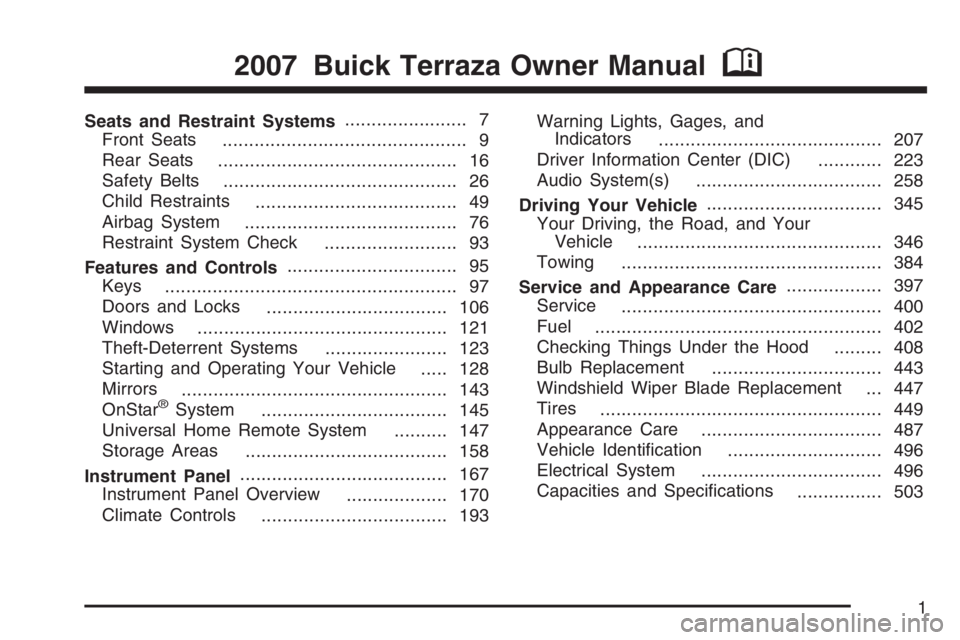
Seats and Restraint Systems....................... 7
Front Seats
.............................................. 9
Rear Seats
............................................. 16
Safety Belts
............................................ 26
Child Restraints
...................................... 49
Airbag System
........................................ 76
Restraint System Check
......................... 93
Features and Controls................................ 95
Keys
....................................................... 97
Doors and Locks
.................................. 106
Windows
............................................... 121
Theft-Deterrent Systems
....................... 123
Starting and Operating Your Vehicle
..... 128
Mirrors
.................................................. 143
OnStar
®System
................................... 145
Universal Home Remote System
.......... 147
Storage Areas
...................................... 158
Instrument Panel....................................... 167
Instrument Panel Overview
................... 170
Climate Controls
................................... 193Warning Lights, Gages, and
Indicators
.......................................... 207
Driver Information Center (DIC)
............ 223
Audio System(s)
................................... 258
Driving Your Vehicle................................. 345
Your Driving, the Road, and Your
Vehicle
.............................................. 346
Towing
................................................. 384
Service and Appearance Care.................. 397
Service
................................................. 400
Fuel
...................................................... 402
Checking Things Under the Hood
......... 408
Bulb Replacement
................................ 443
Windshield Wiper Blade Replacement
... 447
Tires
..................................................... 449
Appearance Care
.................................. 487
Vehicle Identi�cation
............................. 496
Electrical System
.................................. 496
Capacities and Speci�cations
................ 503
2007 Buick Terraza Owner ManualM
1
Page 14 of 562
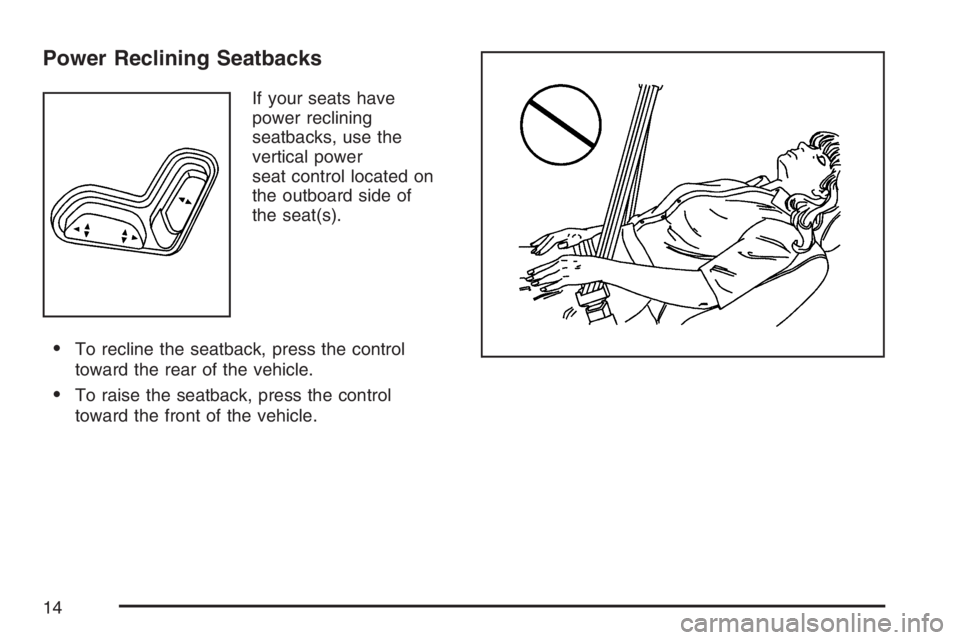
Power Reclining Seatbacks
If your seats have
power reclining
seatbacks, use the
vertical power
seat control located on
the outboard side of
the seat(s).
To recline the seatback, press the control
toward the rear of the vehicle.
To raise the seatback, press the control
toward the front of the vehicle.
14
Page 17 of 562
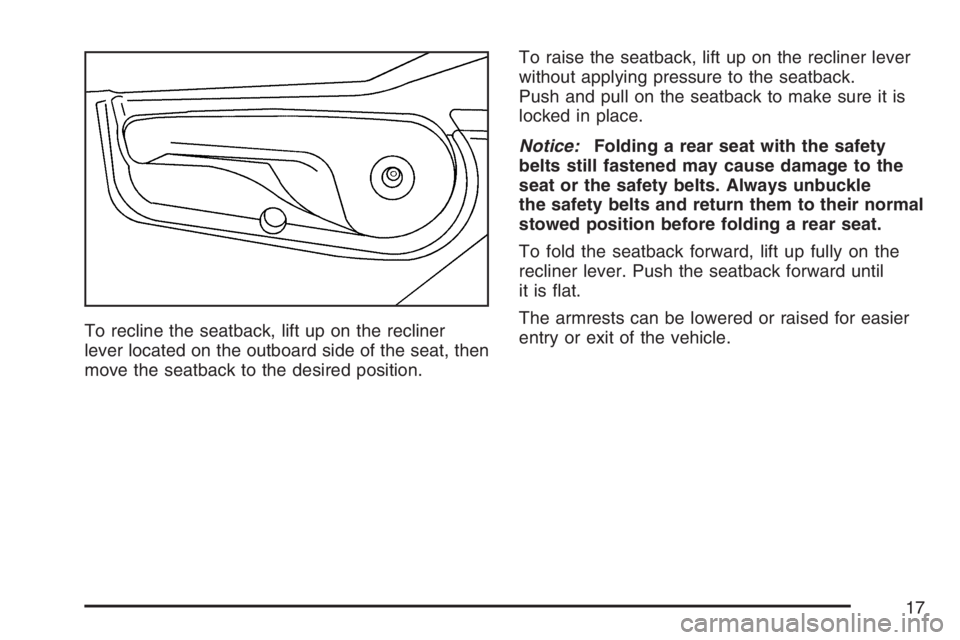
To recline the seatback, lift up on the recliner
lever located on the outboard side of the seat, then
move the seatback to the desired position.To raise the seatback, lift up on the recliner lever
without applying pressure to the seatback.
Push and pull on the seatback to make sure it is
locked in place.
Notice:Folding a rear seat with the safety
belts still fastened may cause damage to the
seat or the safety belts. Always unbuckle
the safety belts and return them to their normal
stowed position before folding a rear seat.
To fold the seatback forward, lift up fully on the
recliner lever. Push the seatback forward until
it is �at.
The armrests can be lowered or raised for easier
entry or exit of the vehicle.
17
Page 21 of 562
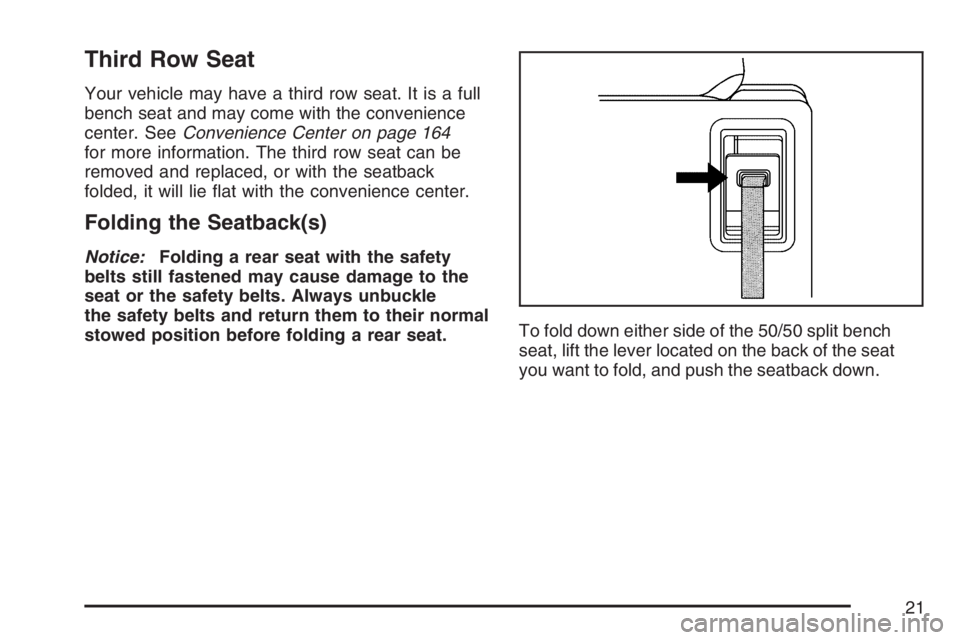
Third Row Seat
Your vehicle may have a third row seat. It is a full
bench seat and may come with the convenience
center. SeeConvenience Center on page 164
for more information. The third row seat can be
removed and replaced, or with the seatback
folded, it will lie �at with the convenience center.
Folding the Seatback(s)
Notice:Folding a rear seat with the safety
belts still fastened may cause damage to the
seat or the safety belts. Always unbuckle
the safety belts and return them to their normal
stowed position before folding a rear seat.To fold down either side of the 50/50 split bench
seat, lift the lever located on the back of the seat
you want to fold, and push the seatback down.
21
Page 23 of 562

Removing the Third Row Seat
1. Remove the convenience center, if equipped.
SeeConvenience Center on page 164for
more information.
2. Make sure all items are off the seat.
Notice:Folding a rear seat with the safety
belts still fastened may cause damage to the
seat or the safety belts. Always unbuckle
the safety belts and return them to their normal
stowed position before folding a rear seat.
3. Put the seatback in its folded position before
removing the seat. See “Folding the
Seatback(s)” earlier in this section.
4. From behind the seat, squeeze the release
handle until the pin indicators are fully out.
This indicates that the rear latches are
released from the �oor. For ease of removing
the seat, squeeze the handle with the palm
of your hand up.
5. Lift the seat slightly from the �oor to ensure
the latches are clear of the �oor pins.
6. Pull the seat rearward and out of the vehicle.
The release handle can be used to carry
the seat.
23
Page 24 of 562
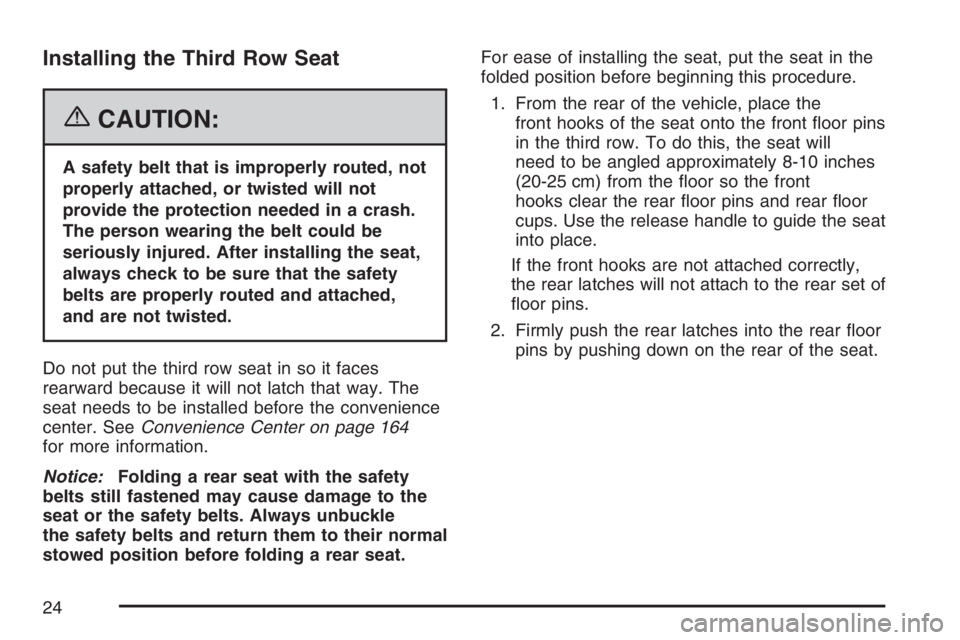
Installing the Third Row Seat
{CAUTION:
A safety belt that is improperly routed, not
properly attached, or twisted will not
provide the protection needed in a crash.
The person wearing the belt could be
seriously injured. After installing the seat,
always check to be sure that the safety
belts are properly routed and attached,
and are not twisted.
Do not put the third row seat in so it faces
rearward because it will not latch that way. The
seat needs to be installed before the convenience
center. SeeConvenience Center on page 164
for more information.
Notice:Folding a rear seat with the safety
belts still fastened may cause damage to the
seat or the safety belts. Always unbuckle
the safety belts and return them to their normal
stowed position before folding a rear seat.For ease of installing the seat, put the seat in the
folded position before beginning this procedure.
1. From the rear of the vehicle, place the
front hooks of the seat onto the front �oor pins
in the third row. To do this, the seat will
need to be angled approximately 8-10 inches
(20-25 cm) from the �oor so the front
hooks clear the rear �oor pins and rear �oor
cups. Use the release handle to guide the seat
into place.
If the front hooks are not attached correctly,
the rear latches will not attach to the rear set of
�oor pins.
2. Firmly push the rear latches into the rear �oor
pins by pushing down on the rear of the seat.
24
Page 50 of 562
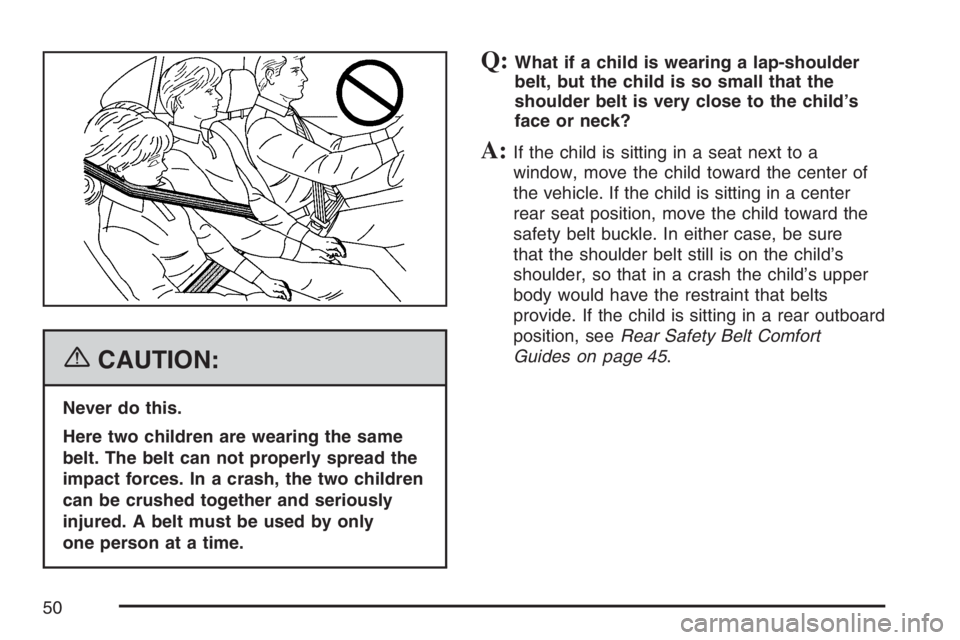
{CAUTION:
Never do this.
Here two children are wearing the same
belt. The belt can not properly spread the
impact forces. In a crash, the two children
can be crushed together and seriously
injured. A belt must be used by only
one person at a time.
Q:What if a child is wearing a lap-shoulder
belt, but the child is so small that the
shoulder belt is very close to the child’s
face or neck?
A:If the child is sitting in a seat next to a
window, move the child toward the center of
the vehicle. If the child is sitting in a center
rear seat position, move the child toward the
safety belt buckle. In either case, be sure
that the shoulder belt still is on the child’s
shoulder, so that in a crash the child’s upper
body would have the restraint that belts
provide. If the child is sitting in a rear outboard
position, seeRear Safety Belt Comfort
Guides on page 45.
50
Page 55 of 562
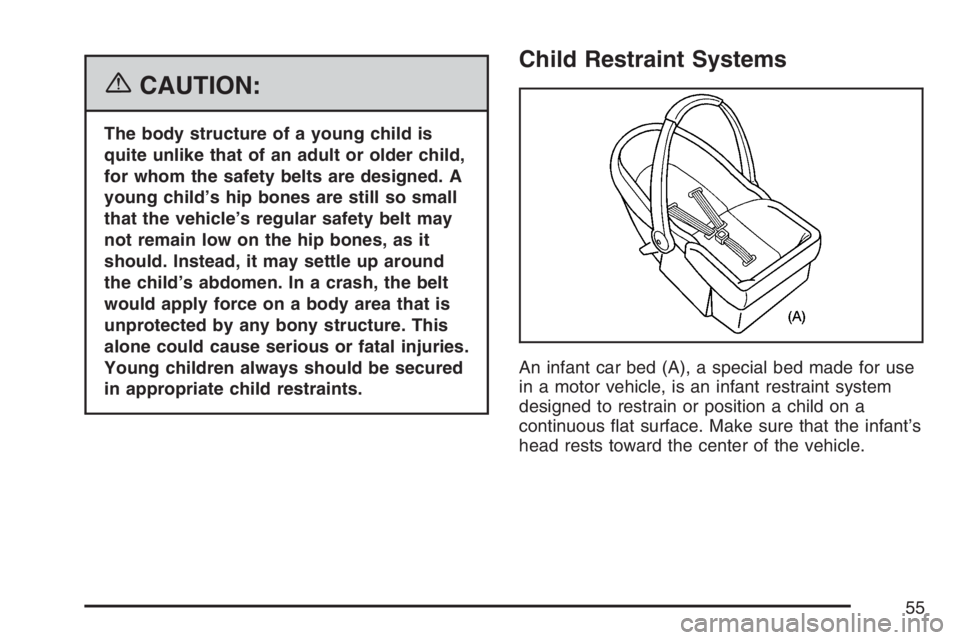
{CAUTION:
The body structure of a young child is
quite unlike that of an adult or older child,
for whom the safety belts are designed. A
young child’s hip bones are still so small
that the vehicle’s regular safety belt may
not remain low on the hip bones, as it
should. Instead, it may settle up around
the child’s abdomen. In a crash, the belt
would apply force on a body area that is
unprotected by any bony structure. This
alone could cause serious or fatal injuries.
Young children always should be secured
in appropriate child restraints.
Child Restraint Systems
An infant car bed (A), a special bed made for use
in a motor vehicle, is an infant restraint system
designed to restrain or position a child on a
continuous �at surface. Make sure that the infant’s
head rests toward the center of the vehicle.
55
Page 67 of 562
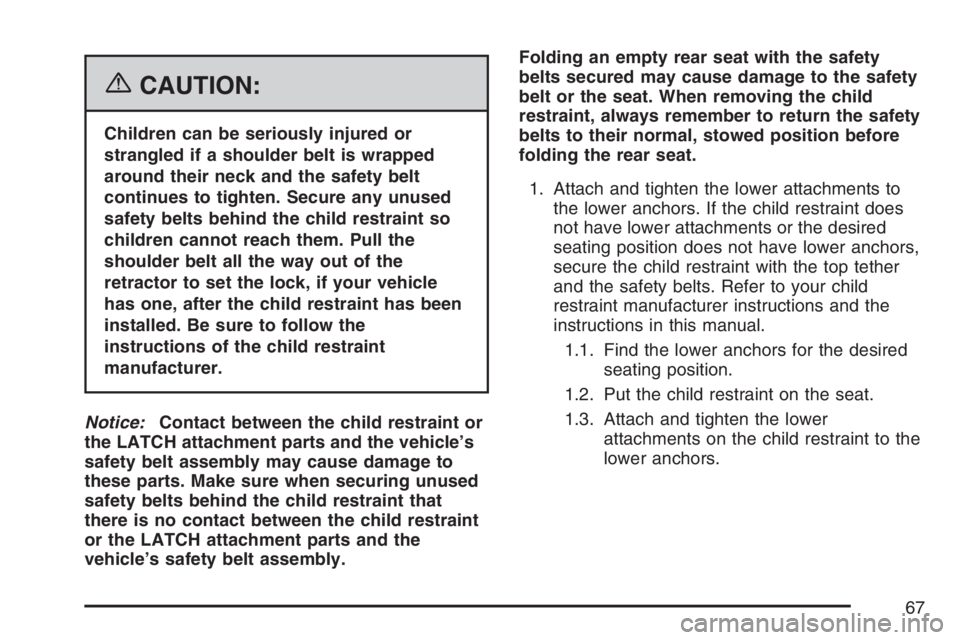
{CAUTION:
Children can be seriously injured or
strangled if a shoulder belt is wrapped
around their neck and the safety belt
continues to tighten. Secure any unused
safety belts behind the child restraint so
children cannot reach them. Pull the
shoulder belt all the way out of the
retractor to set the lock, if your vehicle
has one, after the child restraint has been
installed. Be sure to follow the
instructions of the child restraint
manufacturer.
Notice:Contact between the child restraint or
the LATCH attachment parts and the vehicle’s
safety belt assembly may cause damage to
these parts. Make sure when securing unused
safety belts behind the child restraint that
there is no contact between the child restraint
or the LATCH attachment parts and the
vehicle’s safety belt assembly.Folding an empty rear seat with the safety
belts secured may cause damage to the safety
belt or the seat. When removing the child
restraint, always remember to return the safety
belts to their normal, stowed position before
folding the rear seat.
1. Attach and tighten the lower attachments to
the lower anchors. If the child restraint does
not have lower attachments or the desired
seating position does not have lower anchors,
secure the child restraint with the top tether
and the safety belts. Refer to your child
restraint manufacturer instructions and the
instructions in this manual.
1.1. Find the lower anchors for the desired
seating position.
1.2. Put the child restraint on the seat.
1.3. Attach and tighten the lower
attachments on the child restraint to the
lower anchors.
67
Page 84 of 562
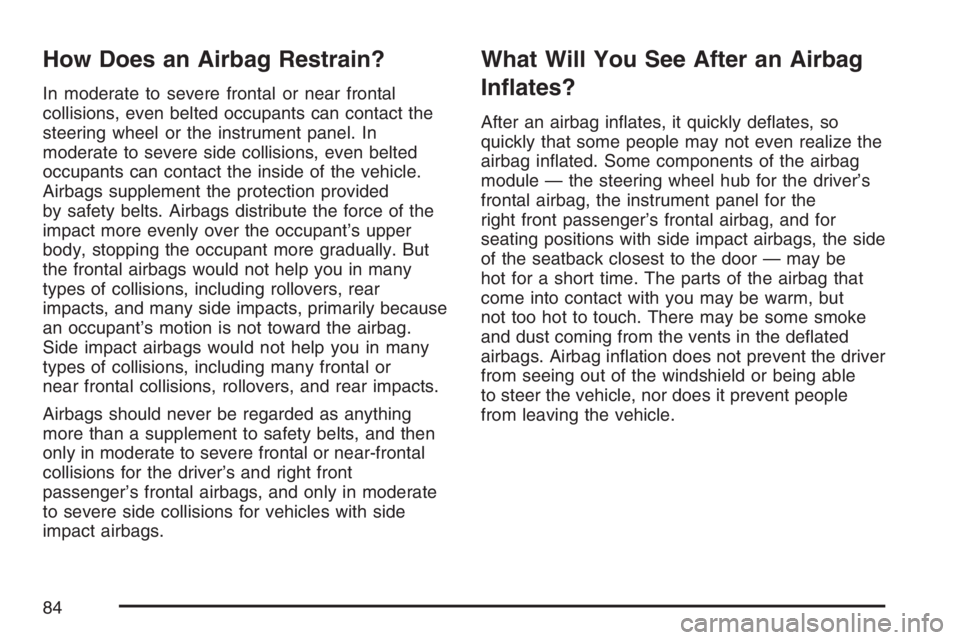
How Does an Airbag Restrain?
In moderate to severe frontal or near frontal
collisions, even belted occupants can contact the
steering wheel or the instrument panel. In
moderate to severe side collisions, even belted
occupants can contact the inside of the vehicle.
Airbags supplement the protection provided
by safety belts. Airbags distribute the force of the
impact more evenly over the occupant’s upper
body, stopping the occupant more gradually. But
the frontal airbags would not help you in many
types of collisions, including rollovers, rear
impacts, and many side impacts, primarily because
an occupant’s motion is not toward the airbag.
Side impact airbags would not help you in many
types of collisions, including many frontal or
near frontal collisions, rollovers, and rear impacts.
Airbags should never be regarded as anything
more than a supplement to safety belts, and then
only in moderate to severe frontal or near-frontal
collisions for the driver’s and right front
passenger’s frontal airbags, and only in moderate
to severe side collisions for vehicles with side
impact airbags.
What Will You See After an Airbag
In�ates?
After an airbag in�ates, it quickly de�ates, so
quickly that some people may not even realize the
airbag in�ated. Some components of the airbag
module — the steering wheel hub for the driver’s
frontal airbag, the instrument panel for the
right front passenger’s frontal airbag, and for
seating positions with side impact airbags, the side
of the seatback closest to the door — may be
hot for a short time. The parts of the airbag that
come into contact with you may be warm, but
not too hot to touch. There may be some smoke
and dust coming from the vents in the de�ated
airbags. Airbag in�ation does not prevent the driver
from seeing out of the windshield or being able
to steer the vehicle, nor does it prevent people
from leaving the vehicle.
84